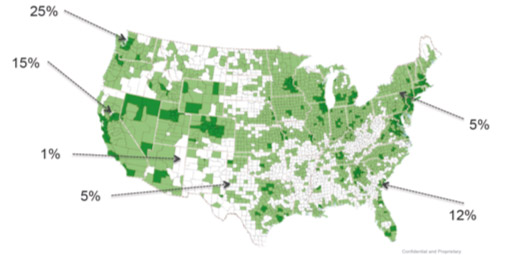Clayton is right, God does not average
When you think of your business as a single number…

… you don’t see the details needed to drive growth.

I used to do a lot of mapping like you see above. Based on what I know today, mapping is irrelevant. It’s almost impossible to show the detailed segmentation that exist almost everywhere. It’s true that there are Geographic patterns but I think it leads people down the wrong path.
This simple example indicates the great opportunities that most businesses have if they would just segment their customer base a bit more. in this example, the first picture indicates an average view of the entire country – as 16%. A business that has a 16% market share across the United States is a very successful business. For this example, 16% would be based upon a calculated Total Addressable Market, not the population as a whole.
A simple breakdown of that calculated Total Addressable Market by county or zipcode indicates great diversity in market share. I have seen this many times; in one example, a financial services firm was doing well in 50 zip codes… but poorly in all the rest.
My recent work examines total addressable market share not by county or zip code but by creating profiles of what people desire ( why people buy) based on real-world people activities. One might do this to think you’re going to just sell a whole bunch of people something. I look at it the opposite way. The goal is to find people that have a need to get something done using a particular product.
It’s a new and better way to reach people not based on geographical boundaries or late-stage marketing such as cost per click. The precision cuts marketing cost, allowing organizations to focus on the people that desire what they produce. You have more time for creativity, more time for branding, and building better products. You spend less time on media and publishers that are not in any way connected to your goals.
By understanding why people buy and be willing to reconfigure databases not based off of what Clayton Christensen calls “data of the past” but focused on theories of customers and why they choose you to solve their underserved needs. You quickly discover you’re removing the noise from the system and getting to the core issues.